Effective Enrichment and Quantitative Determination of Trace Hg2+ Ions Using CdS-Decorated Cellulose Nanofibrils
Abstract
1. Introduction
2. Experimental Section
2.1. Materials and Methods
2.1.1. Materials
2.1.2. Synthesis of CNFs@CdS Nanoadsorbent
2.1.3. Material Characterization
2.1.4. Recommended Procedure for Trace Hg(II) Extraction
3. Results and Discussion
3.1. Characterization
3.2. Optimization of Solution pH
3.3. Effect of Column Flow Rate
3.4. Eluent Type and Concentration
3.5. Effect of Ionic Strength on Hg(II) Adsorption
3.6. Preconcentration Limit and Breakthrough Studies
3.7. Analytical Methods’ Validation
4. Conclusions
Author Contributions
Funding
Acknowledgments
Conflicts of Interest
References
- Gleick, P.H. Global Freshwater Resources: Soft-Path Solutions for the 21st Century. Science 2003, 302, 1524. [Google Scholar] [CrossRef] [PubMed]
- Ho, G. Technology for sustainability: The role of onsite, small and community scale technology. Water Sci. Technol. 2005, 51, 15–20. [Google Scholar] [CrossRef] [PubMed]
- WHO. Drinking Water, Fact Sheet No. 391, in, Media Centre. 2015. Available online: http://www.who.int/mediacentre/factsheets (accessed on 1 October 2020).
- Connor, R. The United Nations World Water Development Report 2015: Water for a Sustainable World; UNESCO Publishing: Paris, France, 2015. [Google Scholar]
- Tchounwou, P.B.; Yedjou, C.G.; Patlolla, A.K.; Sutton, D.J. Heavy metal toxicity and the environment. Exp. Suppl. 2012, 101, 133–164. [Google Scholar] [PubMed]
- Cadar, O.; Miclean, M.; Cadar, S.; Tanaselia, C.; Senila, L.; Senila, M. Assessment of heavy metals in cows milk in rodnei mountains area, romania. Environ. Eng. Manag. J. 2015, 14, 2523–2528. [Google Scholar] [CrossRef]
- Yang, L.; Zhang, Y.; Wang, F.; Luo, Z.; Guo, S.; Strähle, U. Toxicity of mercury: Molecular evidence. Chemosphere 2020, 245, 125586. [Google Scholar] [CrossRef] [PubMed]
- Clarkson, T.W.; Magos, L. The toxicology of mercury and its chemical compounds. Crit. Rev. Toxicol. 2006, 36, 609–662. [Google Scholar] [CrossRef] [PubMed]
- Bensefa-Colas, L.; Andujar, P.; Descatha, A. Mercury poisoning. La Rev. Med. Interne 2011, 32, 416–424. [Google Scholar] [CrossRef]
- Carocci, A.; Rovito, N.; Sinicropi, M.S.; Genchi, G. Mercury toxicity and neurodegenerative effects. Rev. Environ. Contam Toxicol. 2014, 229, 1–18. [Google Scholar]
- Aschner, M.; Carvalho, C. The biochemistry of mercury toxicity, Biochimica et biophysica acta. Gen. Subj. 2019, 1863, 129412. [Google Scholar] [CrossRef] [PubMed]
- Andreoli, V.; Sprovieri, F. Genetic Aspects of Susceptibility to Mercury Toxicity: An Overview. Int. J. Environ. Res. Public Health 2017, 14, 93. [Google Scholar] [CrossRef]
- World Health Organization—International Programme on Chemical Safety. Available online: https://www.who.int/ipcs/assessment/public_health/mercury/en/ (accessed on 1 October 2020).
- Gómez-Ariza, J.L.; Lorenzo, F.; García-Barrera, T. Comparative study of atomic fluorescence spectroscopy and inductively coupled plasma mass spectrometry for mercury and arsenic multispeciation. Anal. Bioanal. Chem. 2005, 382, 485–492. [Google Scholar] [CrossRef]
- Da Silva, D.L.F.; da Costa, M.A.P.; Silva, L.O.B.; Santos, W.N.L.D. Simultaneous determination of mercury and selenium in fish by CVG AFS. Food Chem. 2019, 273, 24–30. [Google Scholar] [CrossRef]
- Suvarapu, L.N.; Baek, S.O. Recent Studies on the Speciation and Determination of Mercury in Different Environmental Matrices Using Various Analytical Techniques. Int. J. Anal. Chem. 2017, 2017, 3624015. [Google Scholar] [CrossRef]
- Rahman, M.T.; Kabir, M.F.; Gurung, A.; Reza, K.M.; Pathak, R.; Ghimire, N.; Baride, A.; Wang, Z.; Kumar, M.; Qiao, Q. Graphene Oxide–Silver Nanowire Nanocomposites for Enhanced Sensing of Hg2+. ACS Appl. Nano Mater. 2019, 2, 4842–4851. [Google Scholar] [CrossRef]
- Hu, M.; Tian, H.; He, J. Unprecedented Selectivity and Rapid Uptake of CuS Nanostructures toward Hg(II) Ions. ACS Appl. Mater. Interfaces 2019, 11, 19200–19206. [Google Scholar] [CrossRef]
- Niu, Y.; Liu, H.; Qu, R.; Liang, S.; Chen, H.; Sun, C.; Cui, Y. Preparation and Characterization of Thiourea-Containing Silica Gel Hybrid Materials for Hg(II) Adsorption. Ind. Eng. Chem. Res. 2015, 54, 1656–1664. [Google Scholar] [CrossRef]
- Zhou, Y.; Hu, X.; Zhang, M.; Zhuo, X.; Niu, J. Preparation and Characterization of Modified Cellulose for Adsorption of Cd(II), Hg(II), and Acid Fuchsin from Aqueous Solutions. Ind. Eng. Chem. Res. 2013, 52, 876–884. [Google Scholar] [CrossRef]
- Bouchet, S.; Bérail, S.; Amouroux, D. Hg Compound-Specific Isotope Analysis at Ultratrace Levels Using an on Line Gas Chromatographic Preconcentration and Separation Strategy Coupled to Multicollector-Inductively Coupled Plasma Mass Spectrometry. Anal. Chem. 2018, 90, 7809–7816. [Google Scholar] [CrossRef]
- Fontanals, N.; Pocurull, E.; Borrull, F.; Marcé, R.M. Role of solid-phase extraction in wastewater-based epidemiology. Curr. Opin. Environ. Sci. Health 2019, 9, 26–33. [Google Scholar] [CrossRef]
- Khan, W.A.; Arain, M.B.; Soylak, M. Nanomaterials-based solid phase extraction and solid phase microextraction for heavy metals food toxicity. Food Chem. Toxicol. 2020, 145, 111704. [Google Scholar] [CrossRef]
- Ansari, S.A.; Mohapatra, P.K. A review on solid phase extraction of actinides and lanthanides with amide based extractants. J. Chromatogr. A 2017, 1499, 1–20. [Google Scholar] [CrossRef] [PubMed]
- Tang, S.; Zhang, H.; Lee, H.K. Advances in Sample Extraction. Anal. Chem. 2016, 88, 228–249. [Google Scholar] [CrossRef]
- Li, W.-K.; Shi, Y.-P. Recent advances and applications of carbon nanotubes based composites in magnetic solid-phase extraction. TrAC Trends Anal. Chem. 2019, 118, 652–665. [Google Scholar] [CrossRef]
- Azzouz, A.; Kailasa, S.K.; Lee, S.S.; Rascón, A.J.; Ballesteros, E.; Zhang, M.; Kim, K.-H. Review of nanomaterials as sorbents in solid-phase extraction for environmental samples. TrAC Trends Anal. Chem. 2018, 108, 347–369. [Google Scholar] [CrossRef]
- Herrero-Latorre, C.; Barciela-García, J.; García-Martín, S.; Peña-Crecente, R.M. Graphene and carbon nanotubes as solid phase extraction sorbents for the speciation of chromium: A review. Anal. Chim. Acta 2018, 1002, 1–17. [Google Scholar] [CrossRef] [PubMed]
- Khajeh, M.; Laurent, S.; Dastafkan, K. Nanoadsorbents: Classification, Preparation, and Applications (with Emphasis on Aqueous Media). Chem. Rev. 2013, 113, 7728–7768. [Google Scholar] [CrossRef]
- Gao, M.-R.; Xu, Y.-F.; Jiang, J.; Yu, S.-H. Nanostructured metal chalcogenides: Synthesis, modification, and applications in energy conversion and storage devices. Chem. Soc. Rev. 2013, 42, 2986–3017. [Google Scholar] [CrossRef]
- Li, J.-R.; Wang, X.; Yuan, B.; Fu, M.-L.; Cui, H.-J. Robust removal of heavy metals from water by intercalation chalcogenide [CH3NH3]2xMnxSn3−xS6·0.5H2O. Appl. Surf. Sci. 2014, 320, 112–119. [Google Scholar] [CrossRef]
- Dance, I.G.; Choy, A.; Scudder, M.L. Syntheses, properties, and molecular and crystal structures of (Me4N)4[E4M10(SPh)16] (E = sulfur or selenium; M = zinc or cadmium): Molecular supertetrahedral fragments of the cubic metal chalcogenide lattice. J. Am. Chem. Soc. 1984, 106, 6285–6295. [Google Scholar] [CrossRef]
- Frenzel, J.; Joswig, J.O.; Sarkar, P.; Seifert, G.; Springborg, M. The effects of organisation, embedding and surfactants on the properties of cadmium chalcogenide (CdS, CdSe and CdS/CdSe) semiconductor nanoparticles. Eur. J. Inorg. Chem. 2005, 2005, 3585–3596. [Google Scholar] [CrossRef]
- Sanville, E.; Burnin, A.; Belbruno, J.J. Experimental and computational study of small (N = 1–16) stoichiometric zinc and cadmium chalcogenide clusters. J. Phys. Chem. A 2006, 110, 2378–2386. [Google Scholar] [CrossRef]
- Farrah, H.; Pickering, W.F. pH effects in the adsorption of heavy metal ions by clays. Chem. Geol. 1979, 25, 317–326. [Google Scholar] [CrossRef]
- Pearson, R.G. Hard and soft acids and bases, HSAB, part II: Underlying theories. J. Chem. Educ. 1968, 45, 643. [Google Scholar] [CrossRef]
- Pearson, R.G. The HSAB principle—More quantitative aspects. Inorg. Chim. Acta 1995, 240, 93–98. [Google Scholar] [CrossRef]
- Razmi, H.; Musevi, S.J.; Rezaei, R.M. Solid phase extraction of mercury(II) using soluble eggshell membrane protein doped with reduced graphene oxide, and its quantitation by anodic stripping voltammetry. Microchim. Acta 2016, 183, 555–562. [Google Scholar] [CrossRef]
- Lopez-Munoz, M.; Arencibia, A.; Cerro, L.; Pascual, R.; Melgar, A. Adsorption of Hg(II) from aqueous solutions using TiO2 and titanate nanotube adsorbents. Appl. Surf. Sci. 2016, 367, 91–100. [Google Scholar] [CrossRef]
- Basadi, N.; Ganemi, K.; Nikpour, Y. L-Cystine-Functionalized Graphene Oxide Nanosheets for Effective Extraction and Preconcentration of Mercury Ions from Environmental Waters. 2020. Available online: https://doi.org/10.1007/s11696-020-01368-y (accessed on 1 October 2020).
- Ozdemir, S.; Kılınç, E.; Fatih, S. A Novel Biosorbent for Preconcentrations of Co(II) and Hg(II) in Real Samples. Sci. Rep. 2020, 10, 455. [Google Scholar] [CrossRef]
- Long, G.L.; Winefordner, J.D. Limit of Detection A Closer Look at the IUPAC Definition. Anal. Chem. 1983, 55, 712A–724A. [Google Scholar]
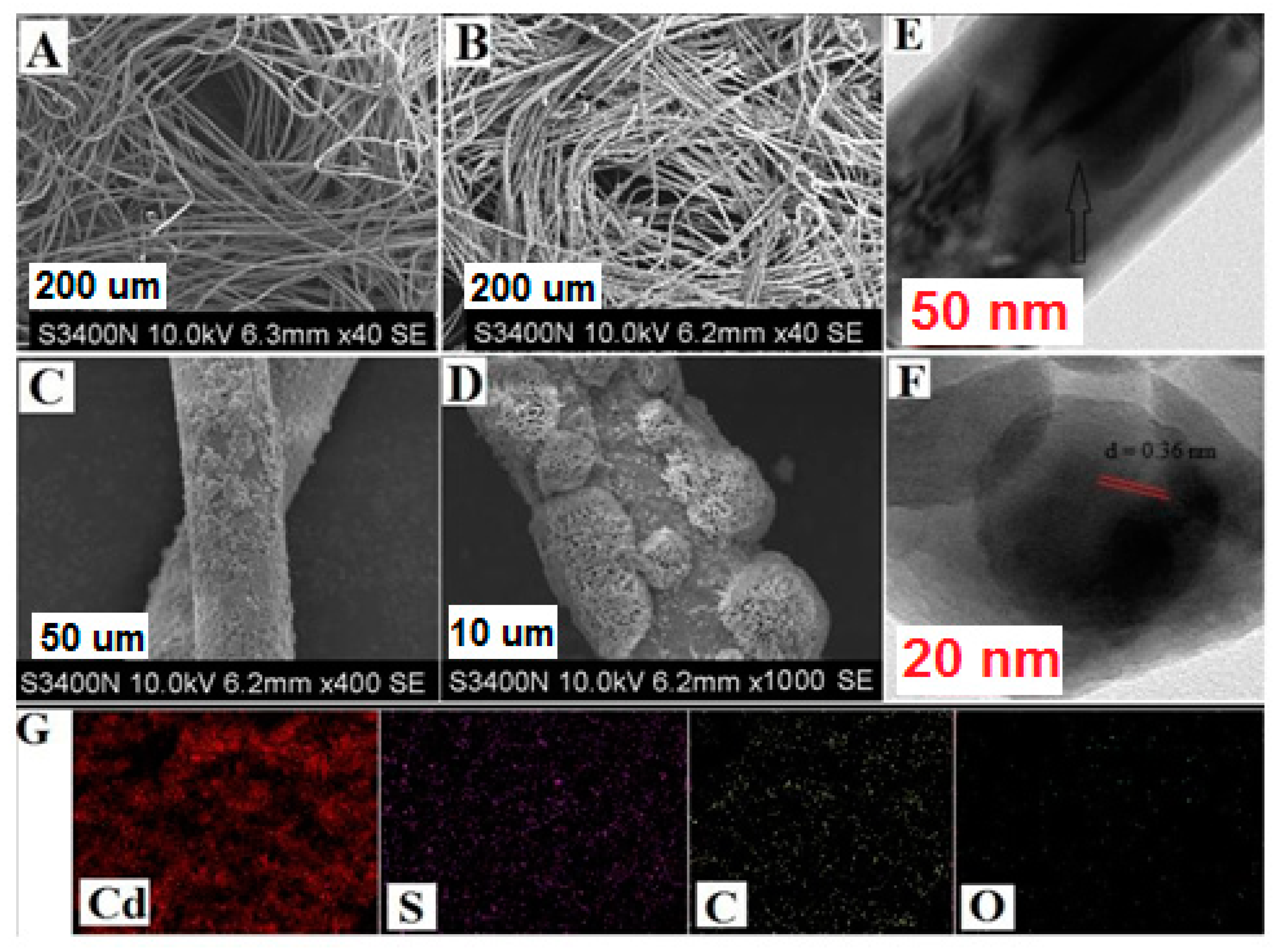
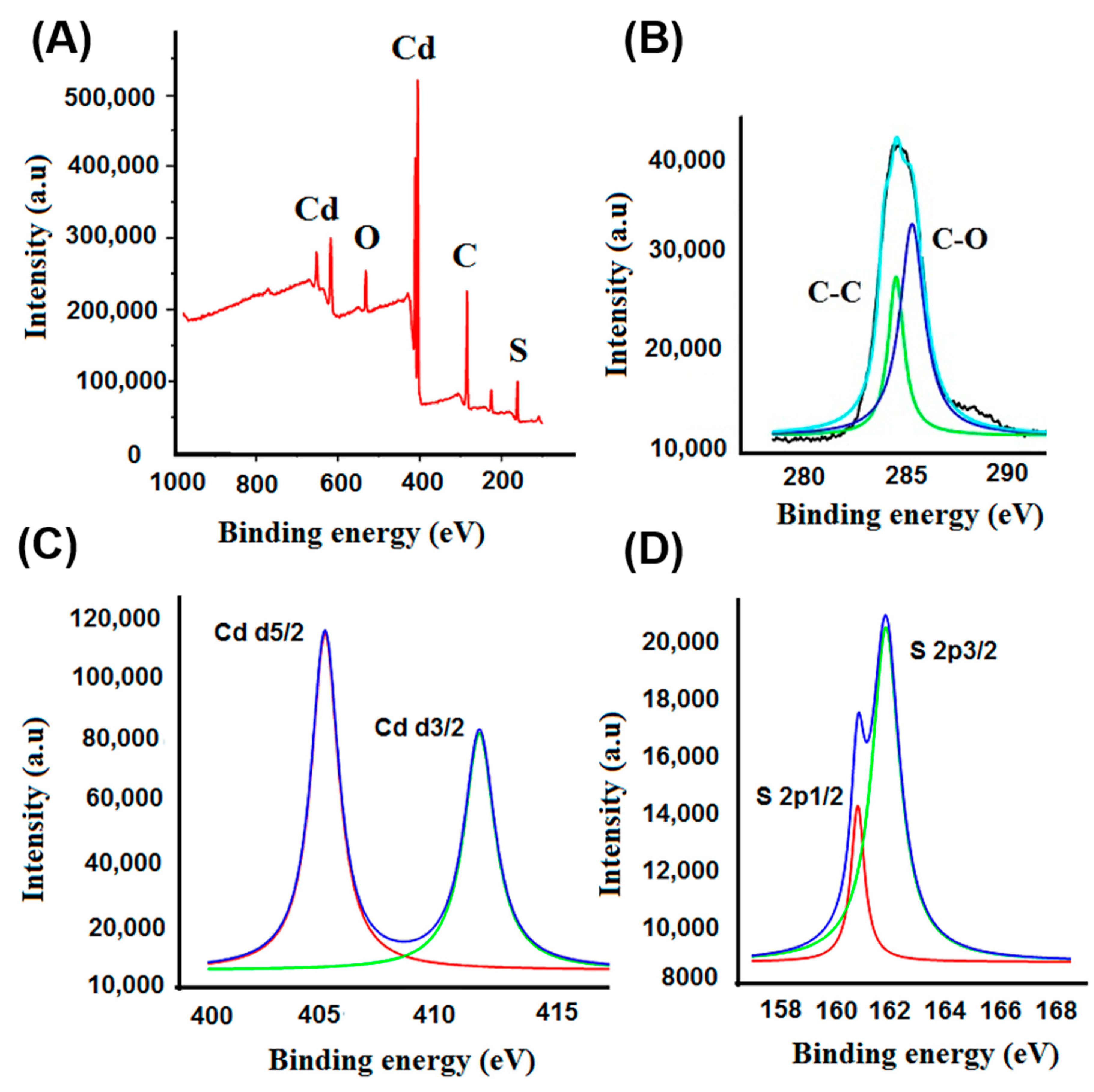
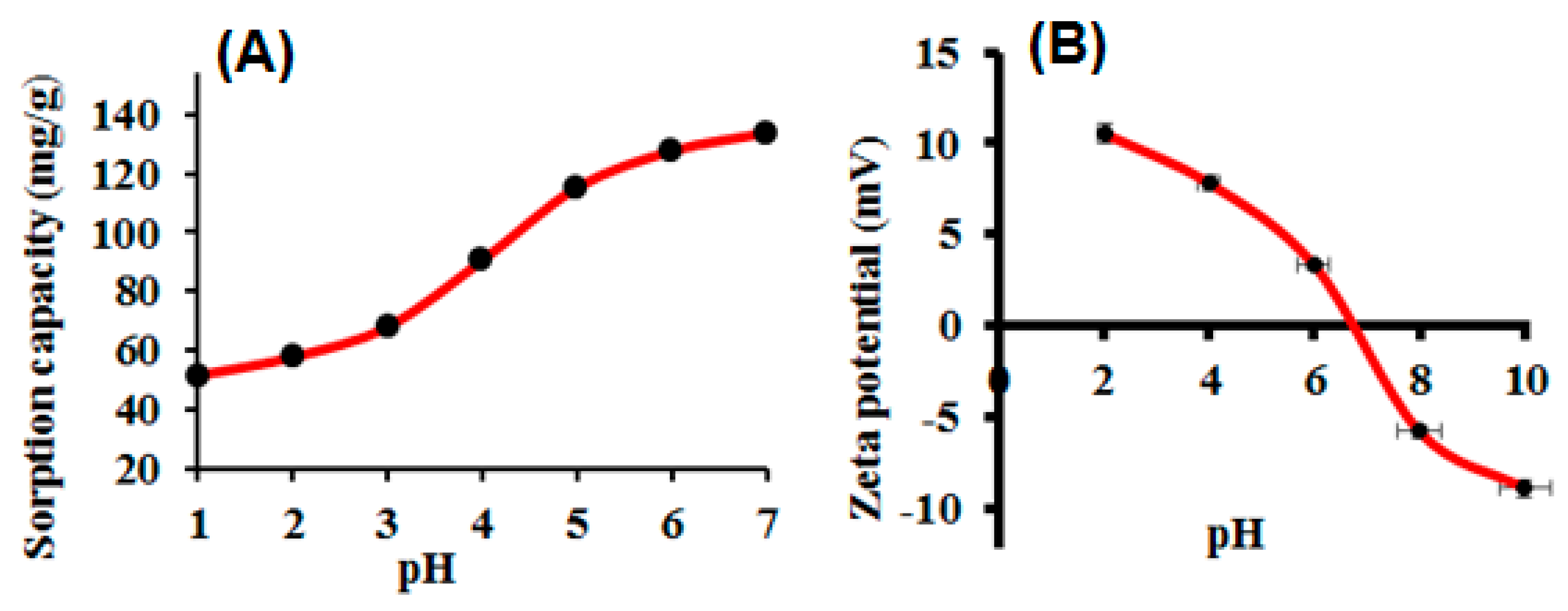
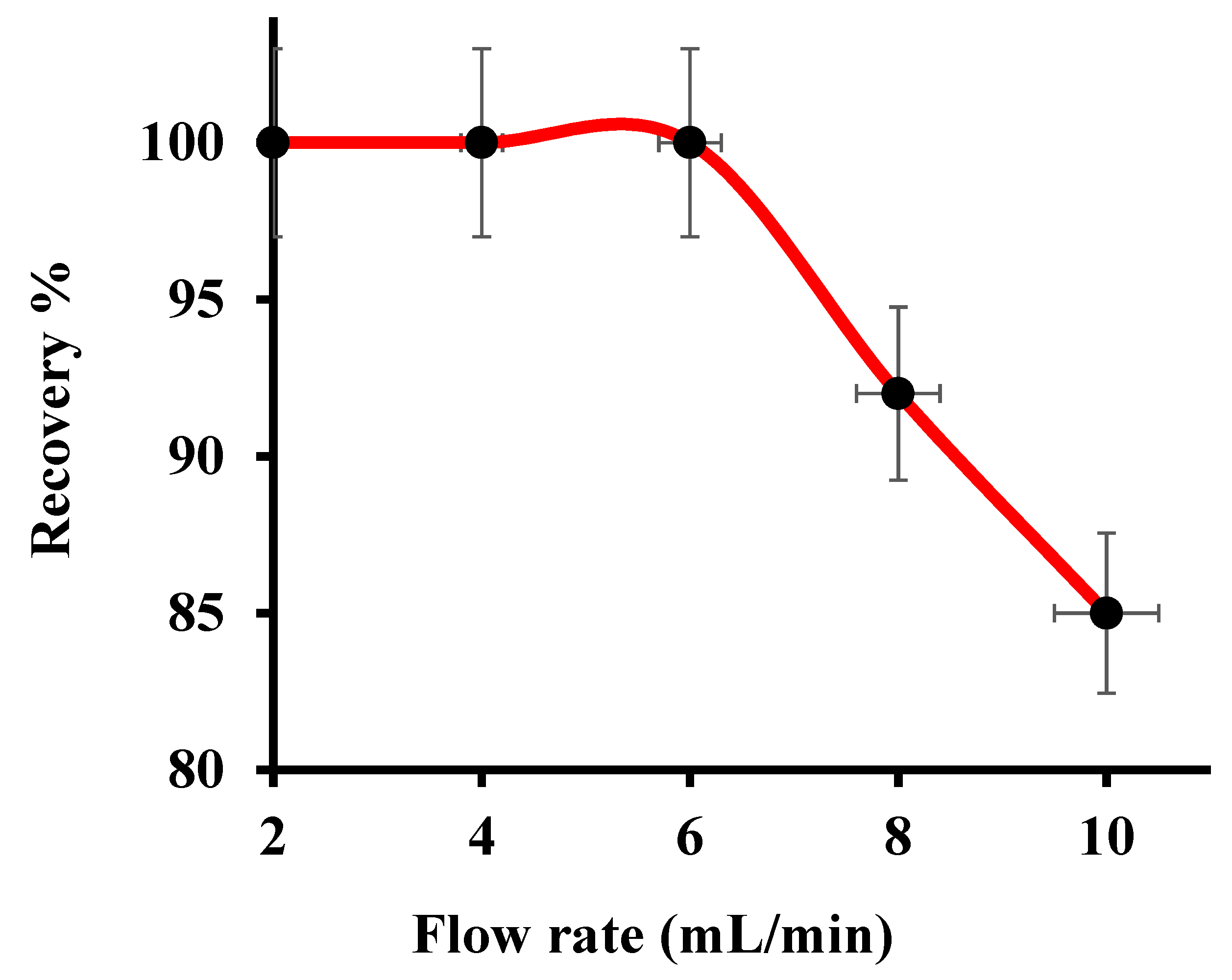

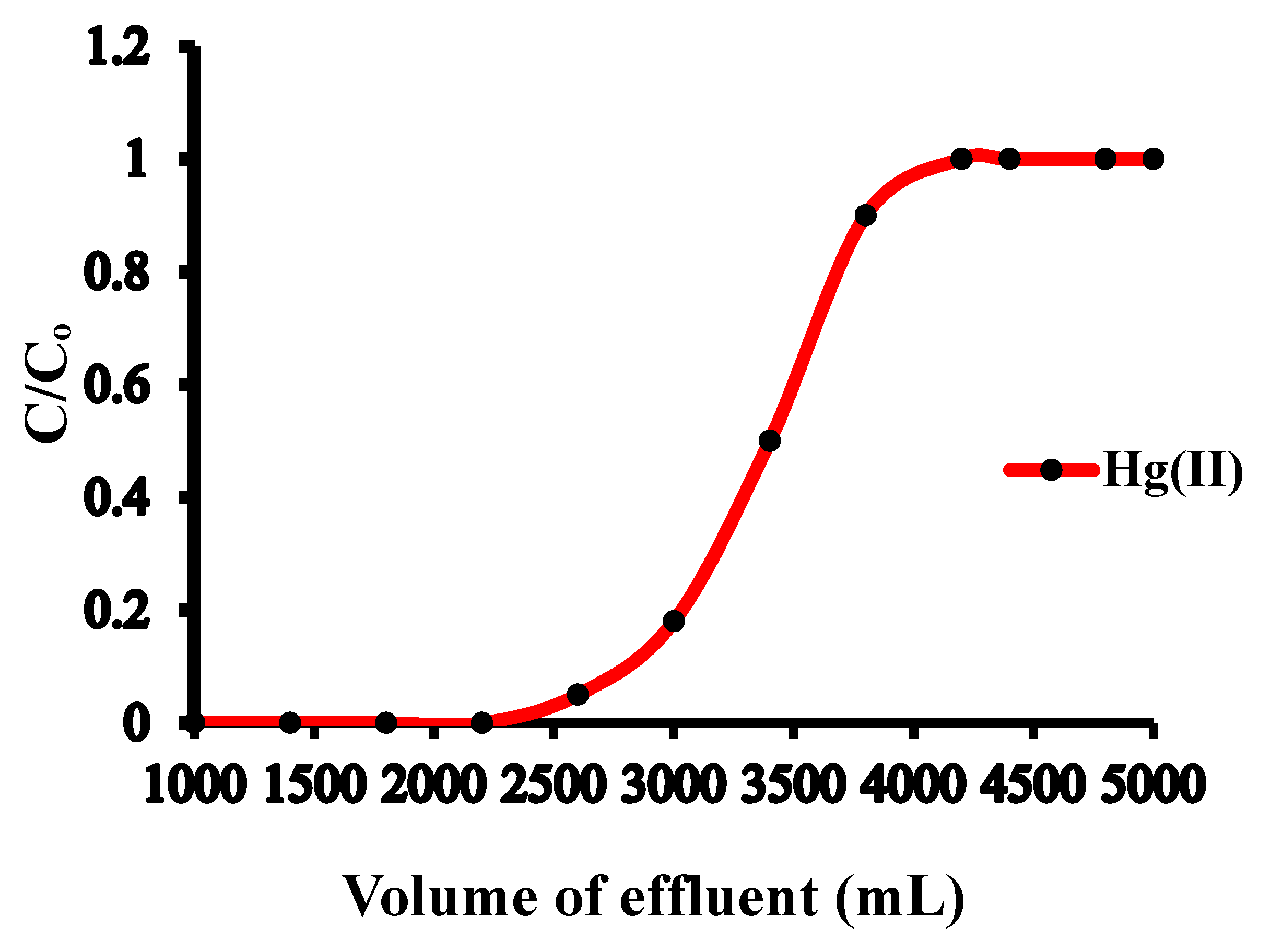
| Element | Peak Position (eV) | Height cps | Atomic % | Area(P) cps | FWHM |
|---|---|---|---|---|---|
| C 1s | 284.82 | 30,985.25 | 61.84 | 84,758.97 | 2.31 |
| O 1s | 531.81 | 10,067.49 | 11.89 | 33,367.52 | 3.00 |
| S 2p | 161.71 | 12,465.10 | 11.5 | 29,568.62 | 2.14 |
| Cd 3d5 | 404.75 | 96,527.63 | 10.78 | 208,022.13 | 2.10 |
| Preconcentration Studies | Breakthrough Studies | ||||
|---|---|---|---|---|---|
| Sample Volume (mL) | Hg(II) (μg L−1) | Preconcentration Limit (μg L−1) | Preconcentration Factor | Breakthrough Volume (mL) | Breakthrough Capacity (mg g−1) |
| 1000 | 1.00 | 1.00 | 200 | 2900 | 126.0 |
| 1500 | 0.67 | 0.67 | 300 | ||
| 2000 | 0.50 | 0.50 | 400 | ||
| 2500 | 0.40 | 0.40 | 500 | ||
| 2800 | 0.36 | 0.36 | 560 | ||
| 3000 | 0.33 | - | - | ||
| Samples | Certified Values (μg g−1) | Values Found by the Proposed Method (μg g−1) ± Standard Deviation a | t-Test b |
|---|---|---|---|
| SRM 1641d | 1.56 ± 0.02 | 1.53 ± 0.52 | 2.37 |
| Samples | Spiked Amount (μg) | Amount Found (μg L−1) ± Standard Deviation a | Recovery Percent (RSD) c | Value of t-Test; at 95% Confidence Level d |
|---|---|---|---|---|
| Tap water | 0 | ND b | - | - |
| 3 | 3.01 ± 0.53 | 100.3 (2.46) | 0.952 | |
| 5 | 4.98 ± 0.71 | 99.6 (2.24) | 1.273 | |
| 0 | 4.8 | - | - | |
| Industrial wastewater | 3 | 7.78 ± 0.87 | 99.3 (3.80) | 1.125 |
| River water | 5 | 9.82 ± 0.76 | 100.4 (2.39) | 2.041 |
| 0 | 1.13 ± 0.64 | - | 1.194 | |
| 3 | 4.12 ± 0.25 | 99.7 (1.29) | 1.918 | |
| 5 | 6.18 ± 0.53 | 101 (2.17) | 2.231 |
Publisher’s Note: MDPI stays neutral with regard to jurisdictional claims in published maps and institutional affiliations. |
© 2020 by the authors. Licensee MDPI, Basel, Switzerland. This article is an open access article distributed under the terms and conditions of the Creative Commons Attribution (CC BY) license (http://creativecommons.org/licenses/by/4.0/).
Share and Cite
Ahmad, H.; Sharfan, I.I.B.; Khan, R.A.; Alsalme, A. Effective Enrichment and Quantitative Determination of Trace Hg2+ Ions Using CdS-Decorated Cellulose Nanofibrils. Nanomaterials 2020, 10, 2218. https://doi.org/10.3390/nano10112218
Ahmad H, Sharfan IIB, Khan RA, Alsalme A. Effective Enrichment and Quantitative Determination of Trace Hg2+ Ions Using CdS-Decorated Cellulose Nanofibrils. Nanomaterials. 2020; 10(11):2218. https://doi.org/10.3390/nano10112218
Chicago/Turabian StyleAhmad, Hilal, Ibtisam I. Bin Sharfan, Rais Ahmad Khan, and Ali Alsalme. 2020. "Effective Enrichment and Quantitative Determination of Trace Hg2+ Ions Using CdS-Decorated Cellulose Nanofibrils" Nanomaterials 10, no. 11: 2218. https://doi.org/10.3390/nano10112218
APA StyleAhmad, H., Sharfan, I. I. B., Khan, R. A., & Alsalme, A. (2020). Effective Enrichment and Quantitative Determination of Trace Hg2+ Ions Using CdS-Decorated Cellulose Nanofibrils. Nanomaterials, 10(11), 2218. https://doi.org/10.3390/nano10112218





